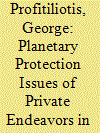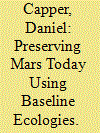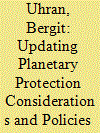|
|
|
Sort Order |
|
|
|
Items / Page
|
|
|
|
|
|
|
| Srl | Item |
| 1 |
ID:
169328


|
|
|
|
|
| Summary/Abstract |
A fundamental requirement for space missions designed to touch “potential habitats” is the single number 10−4, the allowable probability of a single Earth organism contaminating the potential habitat. Many aspects of a mission that affect its complexity and cost—hardware design and manufacture, assembly and test, and mission operations—are driven by this value; therefore, it is important, on the threshold of an era of exploring ocean worlds, to have confidence in it. Yet, despite its long pedigree and occasional reviews, we find that the current requirement lacks programmatically defensible justification. At issue are three weaknesses: (1) microbial biology, in particular the science of extremophiles, is a rapidly changing field; (2) forward contamination (FC) is both a scientific and an ethical issue, yet no ethics-based conversation is apparent within policy-setting circles; and (3) because of these 2 factors, policy-setting cannot be static. We review the history of the requirement, how the evolving understanding of biology could drive it up or down, how the FC hazard relates to risk-management practice and to the ethics profession, and how a contemporary stakeholder conversation could adapt lessons already learned by other fields.
|
|
|
|
|
|
|
|
|
|
|
|
|
|
|
|
| 2 |
ID:
169354


|
|
|
|
|
| Summary/Abstract |
Owing to recent changes in the structure of the aerospace sector and its relationship to government, the landscape of the space industry is now experiencing the emergence of a commercialization paradigm. Private space endeavors may soon be able to target the novel market segments of space research and exploration, space resources utilization, and human access to space and to further stimulate the growth of a new space economy. Thus, the interdisciplinary field of planetary protection has to keep abreast of these advances to avoid unnecessary complications that might hinder the useful reinvigoration of economic interest in the space sector. Planetary protection is defined as a set of guidelines that aim to prevent the forward contamination of celestial bodies with biological material from Earth and the backward contamination of the terrestrial biosphere with extraterrestrial biological material. The possession of the technical capabilities for access to space by more than one private entity is now formulating the public perception of a so-called “Mars Race” that raises significant questions with respect to potential forward and backward contamination issues. This work outlines an environmental economics approach to backward contamination. Specifically, the commercial activities on Mars that may pose backward contamination risks are those that require the return of people, material, vehicles, or other equipment back to Earth, such as the potential business cases of Mars tourism and commercial sample return. Although these activities do not seem to pose a realistic planetary protection risk at present, it would be prudent to consider them during policy-making. Earth-return missions from Mars are expected to generate vigorous public interest worldwide in the environmental, health, and safety risks related to a potential backward contamination incident. As these kinds of missions also involve a post-reentry phase on Earth for the recovery, transfer, reception, and distribution of the samples and for the handling of returned people and equipment, quarantine issues that have not been raised since the Apollo era may become relevant again. In the case of this kind of post-reentry commercial activities, various jurisdictions and laws pertain to the matter. However, public perception will play a key role, as it has done in other industrial development projects with a need for social responsibility. Drawing from terrestrial analogies of siting noxious facilities and other development cases with strong environmental justice characteristics, this work will explore the application of environmental economics as an approach to equitably balance the benefits and costs of future commercial space endeavors with a backward contamination risk.
|
|
|
|
|
|
|
|
|
|
|
|
|
|
|
|
| 3 |
ID:
169347


|
|
|
|
|
| Summary/Abstract |
Current calls to protect the Martian environment with “Planetary Parks” maintain environmental merit. However, they lack a sufficiently urgent timeframe for initiating protection and a robust scientific method for the establishment of noteworthy Martian natural landmarks as natural reserves. In response, if we return to the seminal environmental preservation teachings of Aldo Leopold and John Muir, we encounter the importance of grounding Martian preservation efforts on the fundamental environmental science method of a base-datum of normality, or baseline ecology. This method establishes natural reserves that feature both minimal human interference and known origination dates, thereby providing longitudinal environmental control samples for scientific use. Applied before humans appear on Mars, preserved baseline ecologies thereby aid our scientific understanding of human environmental impacts, both now and well into the future, while they enhance a variety of other outcomes in terms of Martian protection. However, the baseline ecology method requires that, through international agreements, we establish these reserves as quickly as possible and certainly before humans arrive on the planet.
|
|
|
|
|
|
|
|
|
|
|
|
|
|
|
|
| 4 |
ID:
169343


|
|
|
|
|
| Summary/Abstract |
Planetary protection, or the protection of celestial bodies from potentially harmful contamination, has been required by international law since the ratification of the Treaty on Principles Governing the Activities of States in the Exploration and Use of Outer Space in 1967. At that time, scientists were concerned about the potential of contaminating the Moon or bringing back a life form of lunar origin when astronauts returned to Earth with samples. The evidence is that the Moon does not contain indigenous life, but other celestial bodies may. Mars is of particular concern because of its habitability and plans to carry out a robotic sample return mission and even potentially human crewed missions in the near future (next 20–30 years). This article (recognizing that other national and international tasks are ongoing with detailed studies of technical aspects of containment and sample analysis) provides an overview of the policy aspects of planetary protection and sample return, discussing the history of planetary protection, lessons learned from the Apollo missions, and a potential strategy to ensure prevention contamination if a robotic sample return mission is carried out. It is recommended that the capability performed in the 1960s by the Interagency Committee on Back Contamination be reestablished, that regulations be developed to allow quarantine of anyone exposed to the samples, that scientific and technical personnel be trained in a receiving laboratory for at least 2 years prior to sample return, and that a test protocol be established for examining the samples. This will protect our biosphere while enabling groundbreaking research into conditions on Mars and any possible signs of life.
|
|
|
|
|
|
|
|
|
|
|
|
|
|
|
|
|
|
|
|
|